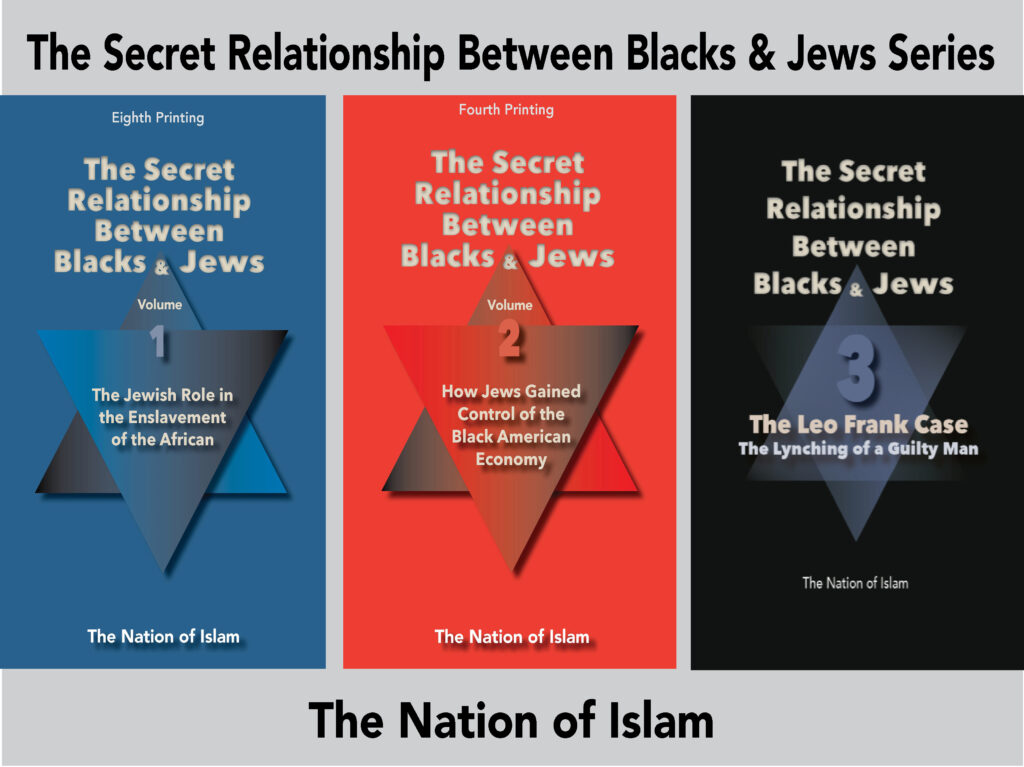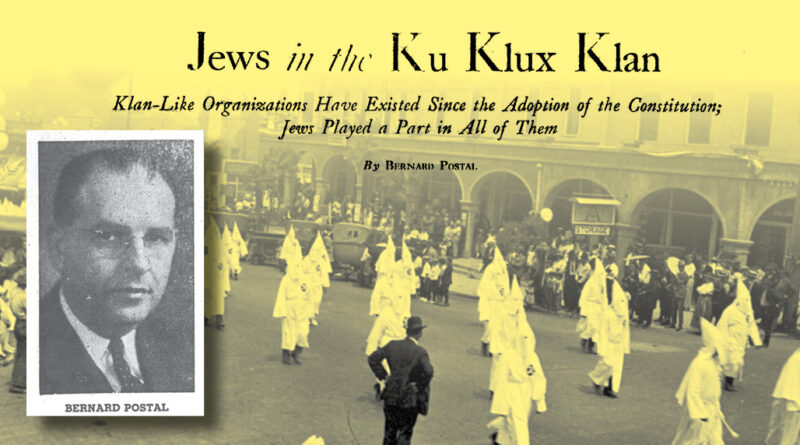Jews in the Ku Klux Klan, 1928 article in the Jewish Tribune
 It may seem surprising to find Jews in the Ku Klux Klan. But that is only a measure of the effectiveness of the Jews’ “civil rights” propaganda in which they present themselves as the historical “friends” of Blacks. This article, “Jews in the Ku Klux Klan,” appeared in the Jewish Tribune’s September 14, 1928, edition, and it shows that long before today’s much-touted “civil rights coalition” Jews were eager to showcase their substantial role in white racial terrorism. The author is BERNARD POSTAL, who is described thus:
It may seem surprising to find Jews in the Ku Klux Klan. But that is only a measure of the effectiveness of the Jews’ “civil rights” propaganda in which they present themselves as the historical “friends” of Blacks. This article, “Jews in the Ku Klux Klan,” appeared in the Jewish Tribune’s September 14, 1928, edition, and it shows that long before today’s much-touted “civil rights coalition” Jews were eager to showcase their substantial role in white racial terrorism. The author is BERNARD POSTAL, who is described thus:
“While Postal was best known for his books on Jewish-American history, he held such posts as editor of the Jewish Daily Bulletin in New York City from 1929 to 1931; editor of the Jersey City Jewish Standard from 1931 to 1933; reporter and editor of Seven Arts Feature Syndicate, a New York Anglo-Jewish news service, from 1933 to 1938; public relations director of B’nai Brith in Washington, D.C., from 1938 to 1946; public relations director for the National Jewish Welfare Board in New York City from 1946 to 1970; and associate editor of Jewish Week. He held early career positions with the New York Times and the Jewish Telegraphic Agency. He founded Jewish Digest in 1955 and its editor until his death….Postal received the American-Jewish Tercentenary Award for contributions to American-Jewish history and various professional honors for his historical and reference writings.”
With this understanding of Postal’s prodigious background in Jewish media—particularly his post in the ADL’s parent organization, B’nai B’rith—here is his article “Jews in the Ku Klux Klan” [pdf version]:
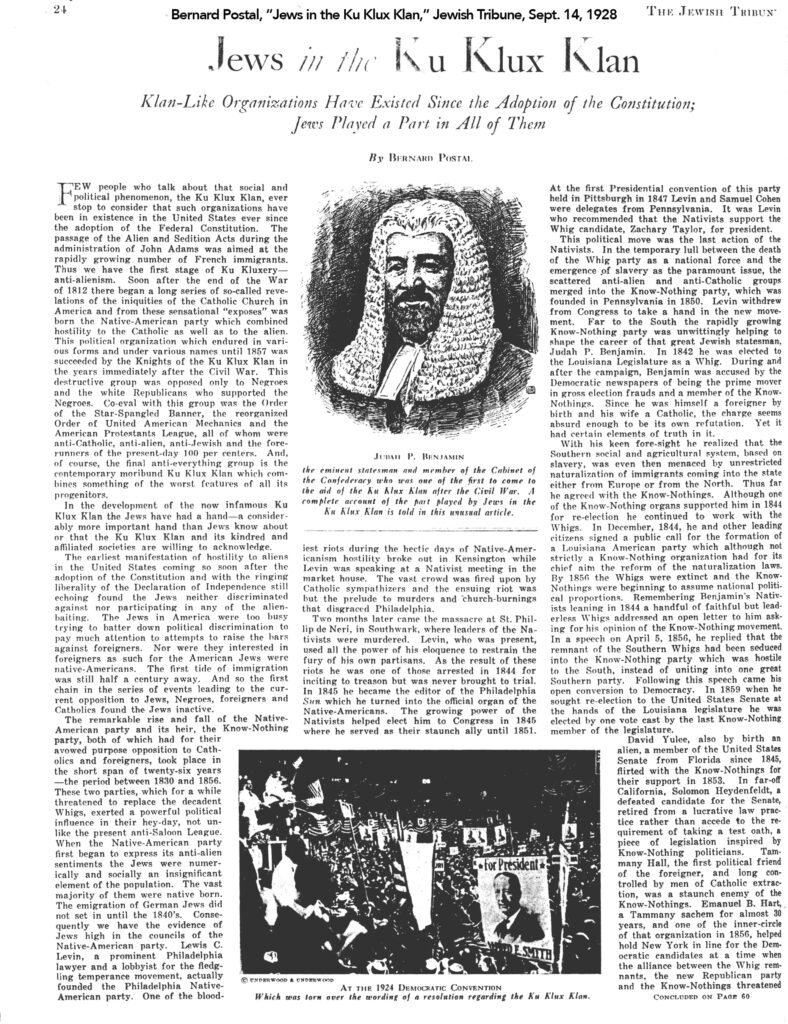
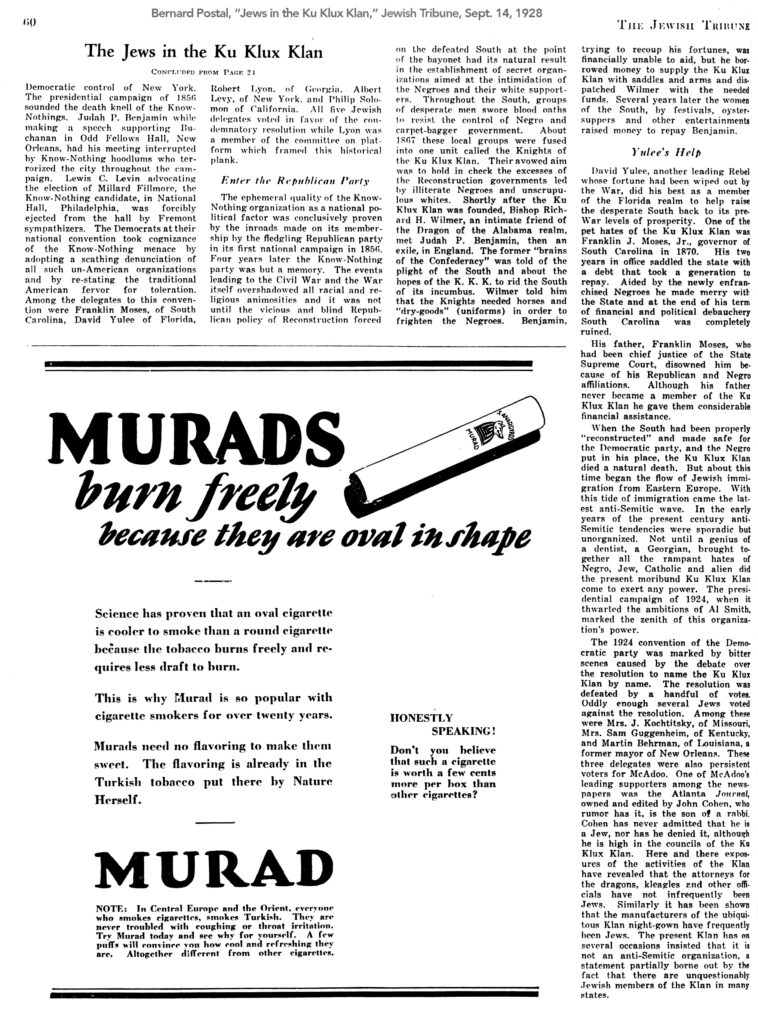
TEXT: Bernard Postal, “Jews in the Ku Klux Klan,” Jewish Tribune, vol. 93, Sept. 14, 1928, pp. 24, 60.
Jews in the Ku Klux Klan
Klan-Like Organizations Have Existed Since the Adoption of the Constitution; Jews Played a Part in All of Them
By Bernard Postal
[PAGE 24] FEW people who talk about that social and political phenomenon, the Ku Klux Klan, ever stop to consider that such organizations have been in existence in the United States ever since the adoption of the Federal Constitution. The passage of the Alien and Sedition Acts during the administration of John Adams was aimed at the rapidly growing number of French immigrants. Thus we have the first stage of Ku Kluxery—anti-alienism. Soon after the end of the War of 1812 there began a long series of so-called revelations of the iniquities of the Catholic Church in America and from these sensational “exposes” was born the Native-American party which combined hostility to the Catholic as well as to the alien. This political organization which endured in various forms and under various names until 1857 was succeeded by the Knights of the Ku Klux Klan in the years immediately after the Civil War. This destructive group was opposed only to Negroes and the white Republicans who supported the Negroes. Co-eval with this group was the Order of the Star-Spangled Banner, the reorganized Order of United American Mechanics and the American Protestants League, all of whom were anti-Catholic, anti-alien, anti-Jewish and the forerunners of the present-day 100 per centers. And, of course, the final anti-everything group is the contemporary moribund Ku Klux Klan which combines something of the worst features of all its progenitors.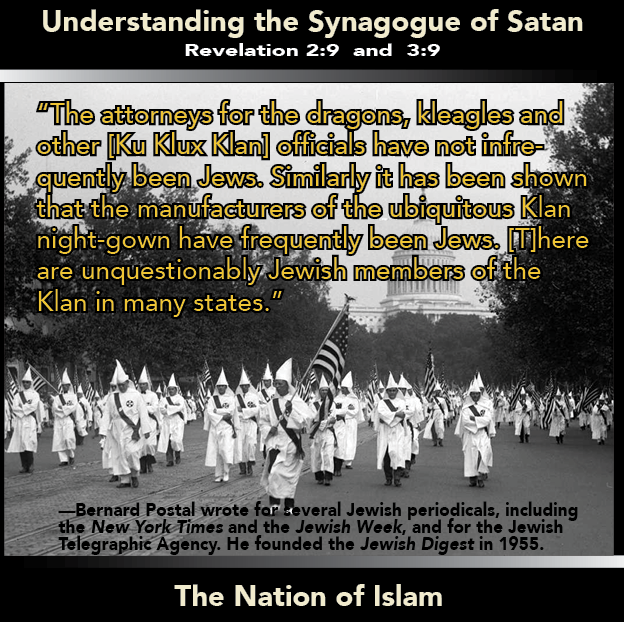
In the development of the now infamous Ku Klux Klan the Jews have had a hand—a considerably more important hand than Jews know about or that the Ku Klux Klan and its kindred and affiliated societies are willing to acknowledge.
The earliest manifestation of hostility to aliens in the United States coming so soon after the adoption of the Constitution and with the ringing liberality of the Declaration of Independence still echoing found the Jews neither discriminated against nor participating in any of the alien-baiting. The Jews in America were too busy trying to batter down political discrimination to pay much attention to attempts to raise the bars against foreigners. Nor were they interested in foreigners as such for the American Jews were native-Americans. The first tide of immigration was still half a century away. And so the first chain in the series of events leading to the current opposition to Jews, Negroes, foreigners and Catholics found the Jews inactive.
The remarkable rise and fall of the Native-American party and its heir, the Know-Nothing party, both of which had for their avowed purpose opposition to Catholics and foreigners, took place in the short span of twenty-six years—the period between 1830 and 1856. These two parties, which for a while threatened to replace the decadent Whigs, exerted a powerful political influence in their hey-day, not unlike the present anti-Saloon League. When the Native-American party first began to express its anti-alien sentiments the Jews were numerically and socially an insignificant element of the population. The vast majority of them were native born. The emigration of German Jews did not set in until the 1840’s. Consequently we have the evidence of Jews high in the councils of the Native-American party. Lewis C. Levin, a prominent Philadelphia lawyer and a lobbyist for the fledgling temperance movement, actually founded the Philadelphia Native-American party. One of the bloodiest riots during the hectic days of Native-Americanism hostility broke out in Kensington while Levin was speaking at a Nativist meeting in the market house. The vast crowd was fired upon by Catholic sympathizers and the ensuing riot was but the prelude to murders and church-burnings that disgraced Philadelphia.
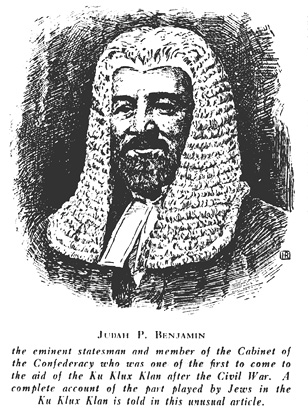
[middle photo caption: “JUDAH P. BENJAMIN the eminent statesman and member of the Cabinet of the Confederacy who was one of the first to come to the aid of the Ku Klux Klan after the Civil War. A complete account of the part played by Jews in the Ku Klux Klan is told in this unusual article.”]
Two months later came the massacre at St. Phillip de Neri, in Southwark, where leaders of the Nativists were murdered. Levin, who was present, used all the power of his eloquence to restrain the fury of his own partisans. As the result of these riots he was one of those arrested in 1844 for inciting to treason but was never brought to trial. In 1845 he became the editor of the Philadelphia Sun which he turned into the official organ of the Native-Americans. The growing power of the Nativists helped elect him to Congress in 1845 where he served as their staunch ally until 1851. At the first Presidential convention of this party held in Pittsburgh in 1847 Levin and Samuel Cohen were delegates from Pennsylvania. It was Levin who recommended that the Nativists support the Whig candidate, Zachary Taylor, for president.
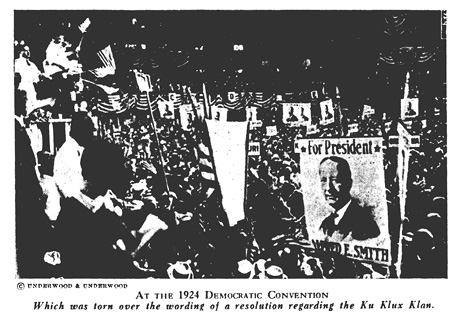
[bottom photo caption: AT THE 1924 DEMOCRATIC CONVENTION Which was torn over the wording of a resolution regarding the Ku Klux Klan.]
This political move was the last action of the Nativists. In the temporary lull between the death of the Whig party as a national force and the emergence of slavery as the paramount issue, the scattered anti-alien and anti-Catholic groups merged into the Know-Nothing party, which was founded in Pennsylvania in 1850. Levin withdrew from Congress to take a hand in the new movement. Far to the South the rapidly growing Know-Nothing party was unwittingly helping to shape the career of that great Jewish statesman, Judah P. Benjamin. In 1842 he was elected to the Louisiana Legislature as a Whig. During and after the campaign, Benjamin was accused by the Democratic newspapers of being the prime mover in gross election frauds and a member of the Know-Nothings. Since he was himself a foreigner by birth and his wife a Catholic, the charge seems absurd enough to be its own refutation. Yet it had certain elements of truth in it.
With his keen fore-sight he realized that the Southern social and agricultural system, based on slavery, was even then menaced by unrestricted naturalization of immigrants coming into the state either from Europe or from the North. Thus far he agreed with the Know-Nothings. Although one of the Know-Nothing organs supported him in 1844 for re-election he continued to work with the Whigs. In December, 1844, he and other leading citizens signed a public call for the formation of a Louisiana American party which although not strictly a Know-Nothing organization had for its chief aim the reform of the naturalization laws. By 1856 the Whigs were extinct and the Know-Nothings were beginning to assume national political proportions. Remembering Benjamin’s Nativists leaning in 1844 a handful of faithful but leaderless Whigs addressed an open letter to him asking for his opinion of the Know-Nothing movement. In a speech on April 5, 1856, he replied that the remnant of the Southern Whigs had been seduced into the Know-Nothing party which was hostile to the South, instead of uniting into one great Southern party. Following this speech came his open conversion to Democracy. In 1859 when he sought re-election to the United States Senate at the hands of the Louisiana legislature he was elected by one vote cast by the last Know-Nothing member of the legislature.
David Yulee, also by birth an alien, a member of the United States Senate from Florida since 1845, flirted with the Know-Nothings for their support in 1853. In far-off California, Solomon Heydenfeldt, a defeated candidate for the Senate, retired from a lucrative law practice rather than accede to the requirement of taking a test oath, a piece of legislation inspired by Know-Nothing politicians. Tammany Hall, the first political friend of the foreigner, and long controlled by men of Catholic extraction, was a staunch enemy of the Know-Nothings. Emanuel B. Hart, a Tammany sachem for almost 30 years, and one of the inner-circle of that organization in 1856, helped hold New York in line for the Democratic candidates at a time when the alliance between the Whig remnants, the new Republican party and the Know-Nothings threatened
[PAGE 60] Democratic control of New York. The presidential campaign of 1856 sounded the death knell of the Know-Nothings. Judah P. Benjamin while making a speech supporting [Democrat James] Buchanan in Odd Fellows Hall, New Orleans, had his meeting interrupted by Know-Nothing hoodlums who terrorized the city throughout the campaign. Lewis C. Levin advocating the election of Millard Fillmore, the Know-Nothing candidate, in National Hall, Philadelphia, was forcibly ejected from the hall by [Republican John C.] Fremont sympathizers. The Democrats at their national convention took cognizance of the Know-Nothing menace by adopting a scathing denunciation of all such un-American organizations and by re-stating the traditional American fervor for toleration. Among the delegates to this convention were Franklin Moses, of South Carolina, David Yulee of Florida, Robert Lyon, of Georgia, Albert Levy, of New York, and Philip Solomon of California. All five Jewish delegates voted in favor of the condemnatory resolution while Lyon was a member of the committee on platform which framed this historical plank.
Enter the Republican Party
The ephemeral quality of the Know-Nothing organization as a national political factor was conclusively proven by the inroads made on its membership by the fledgling Republican party in its first national campaign in 1856. Four years later the Know-Nothing party was but a memory. The events leading to the Civil War and the War itself overshadowed all racial and religious animosities and it was not until the vicious and blind Republican policy of Reconstruction forced on the defeated South at the point of the bayonet had its natural result in the establishment of secret organizations aimed at the intimidation of the Negroes and their white supporters. Throughout the South, groups of desperate men swore blood oaths to resist the control of Negro and carpet-bagger government. About 1867 these local groups were fused into one unit called the Knights of the Ku Klux Klan. Their avowed aim was to hold in check the excesses of the Reconstruction governments led by illiterate Negroes and unscrupulous whites. Shortly after the Ku Klux Klan was founded, Bishop Richard H. Wilmer, an intimate friend of the Dragon of the Alabama realm, met Judah P. Benjamin, then an exile, in England. The former “brains of the Confederacy” was told of the plight of the South and about the hopes of the K. K. K. to rid the South of its incumbus [Sic. Should read: incubus]. Wilmer told him that the Knights needed horses and “dry-goods” (uniforms) in order to frighten the Negroes. Benjamin, trying to recoup his fortunes, was financially unable to aid, but he borrowed money to supply the Ku Klux Klan with saddles and arms and dispatched Wilmer with the needed funds. Several years later the women of the South, by festivals, oyster-suppers and other entertainments raised money to repay Benjamin.
Yulee’s Help
David Yulee, another leading Rebel whose fortune had been wiped out by the War, did his best as a member of the Florida realm to help raise the desperate South back to its pre-War levels of prosperity. One of the pet hates of the Ku Klux was Franklin J. Moses, Jr., governor of South Carolina in 1870. His two years in office saddled the state with a debt that took a generation to repay. Aided by the newly enfranchised Negroes he made merry with the State and at the end of his term of financial and political debauchery South Carolina was completely ruined.
His father, Franklin Moses, who had been chief justice of the State Supreme Court, disowned him because of his Republican and Negro affiliations. Although his father never became a member of the Ku Klux Klan he gave them considerable financial assistance.
When the South had been properly “reconstructed” and made safe for the Democratic party, and the Negro put in his place, the Ku Klux Klan died a natural death. But about this time began the flow of Jewish immigration from Eastern Europe. With this tide of immigration came the latest anti-Semitic wave. In the early years of the present century anti-Semitic tendencies were sporadic but unorganized. Not until a genius of a dentist, a Georgian, brought together all the rampant hates of Negro, Jew, Catholic and alien did the present moribund Ku Klux Klan come to exert any power. The presidential campaign of 1924, when it thwarted the ambitions of Al Smith, marked the zenith of this organization’s power.
The 1924 convention of the Democratic party was marked by bitter scenes caused by the debate over the resolution to name the Ku Klux Klan by name. The resolution was defeated by a handful of votes. Oddly enough several Jews voted against the resolution. Among these were Mrs. J. Kochtitsky, of Missouri, Mrs. Sam Guggenheim, of Kentucky, and Martin Behrman, of Louisiana, a former mayor of New Orleans. These three delegates were also persistent voters for [William G.] McAdoo. One of McAdoo’s leading supporters among the newspapers was the Atlanta Journal, owned and edited by John Cohen, who rumor has it, is the son of a rabbi. Cohen has never admitted that he is a Jew, nor has he denied it, although he is high in the councils of the Ku Klux Klan. Here and there exposures of the activities of the Klan have revealed that the attorneys for the dragons, kleagles and other officials have not infrequently been Jews. Similarly it has been shown that the manufacturers of the ubiquitous Klan night-gown have frequently been Jews. The present Klan has on several occasions insisted that it is not an anti-Semitic organization, a statement partially borne out by the fact that there are unquestionably Jewish members of the Klan in many states.
For more on this topic see the Nation of Islam book series The Secret Relationship Between Blacks & Jews. Download the free guide by clicking here.
To purchase the series click here.
